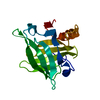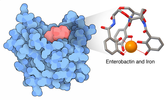+ Open data
Open data
- Basic information
Basic information
| Entry | Database: PDB / ID: 2q2p | ||||||
|---|---|---|---|---|---|---|---|
| Title | Beta-lactoglobulin (reverse native) | ||||||
 Components Components | Beta-lactoglobulin | ||||||
 Keywords Keywords |  TRANSPORT PROTEIN / TRANSPORT PROTEIN /  LIPOCALIN / VARIANT A LIPOCALIN / VARIANT A | ||||||
| Function / homology |  Function and homology information Function and homology information retinol binding / retinol binding /  long-chain fatty acid binding / long-chain fatty acid binding /  extracellular space / identical protein binding extracellular space / identical protein bindingSimilarity search - Function | ||||||
| Biological species |   Bos taurus (cattle) Bos taurus (cattle) | ||||||
| Method |  X-RAY DIFFRACTION / X-RAY DIFFRACTION /  MOLECULAR REPLACEMENT / Resolution: 2.96 Å MOLECULAR REPLACEMENT / Resolution: 2.96 Å | ||||||
 Authors Authors | Vijayalakshmi, L. / Krishna, R. / Sankaranarayanan, R. / Vijayan, M. | ||||||
 Citation Citation |  Journal: Proteins / Year: 2007 Journal: Proteins / Year: 2007Title: An asymmetric dimer of beta-lactoglobulin in a low humidity crystal form-Structural changes that accompany partial dehydration and protein action. Authors: Vijayalakshmi, L. / Krishna, R. / Sankaranarayanan, R. / Vijayan, M. | ||||||
| History |
|
- Structure visualization
Structure visualization
| Structure viewer | Molecule:  Molmil Molmil Jmol/JSmol Jmol/JSmol |
|---|
- Downloads & links
Downloads & links
- Download
Download
| PDBx/mmCIF format |  2q2p.cif.gz 2q2p.cif.gz | 40.3 KB | Display |  PDBx/mmCIF format PDBx/mmCIF format |
|---|---|---|---|---|
| PDB format |  pdb2q2p.ent.gz pdb2q2p.ent.gz | 27.7 KB | Display |  PDB format PDB format |
| PDBx/mmJSON format |  2q2p.json.gz 2q2p.json.gz | Tree view |  PDBx/mmJSON format PDBx/mmJSON format | |
| Others |  Other downloads Other downloads |
-Validation report
| Arichive directory |  https://data.pdbj.org/pub/pdb/validation_reports/q2/2q2p https://data.pdbj.org/pub/pdb/validation_reports/q2/2q2p ftp://data.pdbj.org/pub/pdb/validation_reports/q2/2q2p ftp://data.pdbj.org/pub/pdb/validation_reports/q2/2q2p | HTTPS FTP |
|---|
-Related structure data
| Related structure data |  2q2mC  2q39C  1b8eS S: Starting model for refinement C: citing same article ( |
|---|---|
| Similar structure data |
- Links
Links
- Assembly
Assembly
| Deposited unit | 
| ||||||||
|---|---|---|---|---|---|---|---|---|---|
| 1 | 
| ||||||||
| Unit cell |
| ||||||||
| Details | The second part of the biological assembly is generated by the two fold axis: 2-x,y,1/2-z |
- Components
Components
| #1: Protein |  / Beta-LG / Allergen Bos d 5 / Beta-LG / Allergen Bos d 5Mass: 18387.264 Da / Num. of mol.: 1 / Source method: isolated from a natural source Details: VARIANT A DIFFERS IN A PRIMARY AMINO ACID SEQUENCE FROM VARIANT B AT POSITIONS 64 (ASP-->GLY) AND 118 (VAL-->ALA) Source: (natural)   Bos taurus (cattle) / Organ: BREAST / Variant: A / Tissue: MAMMARY GLAND Bos taurus (cattle) / Organ: BREAST / Variant: A / Tissue: MAMMARY GLAND / References: UniProt: P02754 / References: UniProt: P02754 |
|---|---|
| #2: Water | ChemComp-HOH /  Water Water |
-Experimental details
-Experiment
| Experiment | Method:  X-RAY DIFFRACTION / Number of used crystals: 1 X-RAY DIFFRACTION / Number of used crystals: 1 |
|---|
- Sample preparation
Sample preparation
| Crystal | Density Matthews: 2.09 Å3/Da / Density % sol: 41.15 % |
|---|---|
Crystal grow | Temperature: 293 K / Method: vapor diffusion, hanging drop / pH: 7.4 Details: 0.01M Hepes, 2.2 to 2.8 M Ammonium sulphate, NAOH, pH 7.40, VAPOR DIFFUSION, HANGING DROP, temperature 293K |
-Data collection
| Diffraction | Mean temperature: 293 K |
|---|---|
| Diffraction source | Source:  ROTATING ANODE / Type: RIGAKU RU200 / Wavelength: 1.5418 ROTATING ANODE / Type: RIGAKU RU200 / Wavelength: 1.5418 |
| Detector | Type: MARRESEARCH / Detector: IMAGE PLATE / Date: May 14, 2004 |
| Radiation | Protocol: SINGLE WAVELENGTH / Monochromatic (M) / Laue (L): M / Scattering type: x-ray |
| Radiation wavelength | Wavelength : 1.5418 Å / Relative weight: 1 : 1.5418 Å / Relative weight: 1 |
| Reflection | Resolution: 2.96→19.85 Å / Num. obs: 3248 / % possible obs: 95.6 % / Observed criterion σ(I): 0 / Biso Wilson estimate: 54.7 Å2 / Rmerge(I) obs: 0.096 / Net I/σ(I): 15 |
| Reflection shell | Resolution: 2.96→3.15 Å / Rmerge(I) obs: 0.499 / Mean I/σ(I) obs: 4.4 / % possible all: 99.4 |
- Processing
Processing
| Software |
| ||||||||||||||||||||
|---|---|---|---|---|---|---|---|---|---|---|---|---|---|---|---|---|---|---|---|---|---|
| Refinement | Method to determine structure : :  MOLECULAR REPLACEMENT MOLECULAR REPLACEMENTStarting model: PDB entry 1B8E Resolution: 2.96→19.84 Å / Rfactor Rfree error: 0.014 / Data cutoff high absF: 1020933.96 / Data cutoff low absF: 0 / Isotropic thermal model: GROUP / Cross valid method: THROUGHOUT / σ(F): 0
| ||||||||||||||||||||
| Solvent computation | Solvent model: FLAT MODEL / Bsol: 49.0171 Å2 / ksol: 0.22153 e/Å3 | ||||||||||||||||||||
| Displacement parameters | Biso mean: 77.2 Å2
| ||||||||||||||||||||
| Refine analyze |
| ||||||||||||||||||||
| Refinement step | Cycle: LAST / Resolution: 2.96→19.84 Å
| ||||||||||||||||||||
| Refine LS restraints |
| ||||||||||||||||||||
| LS refinement shell | Resolution: 2.96→3.15 Å / Rfactor Rfree error: 0.065 / Total num. of bins used: 6
| ||||||||||||||||||||
| Xplor file |
|
 Movie
Movie Controller
Controller













 PDBj
PDBj


